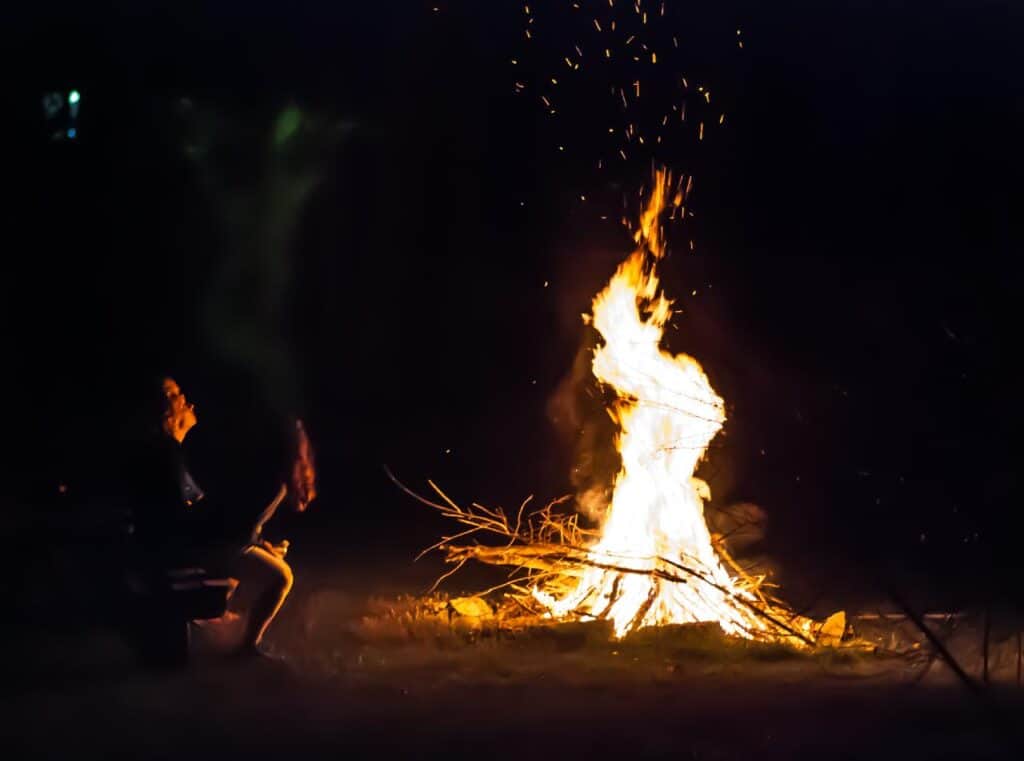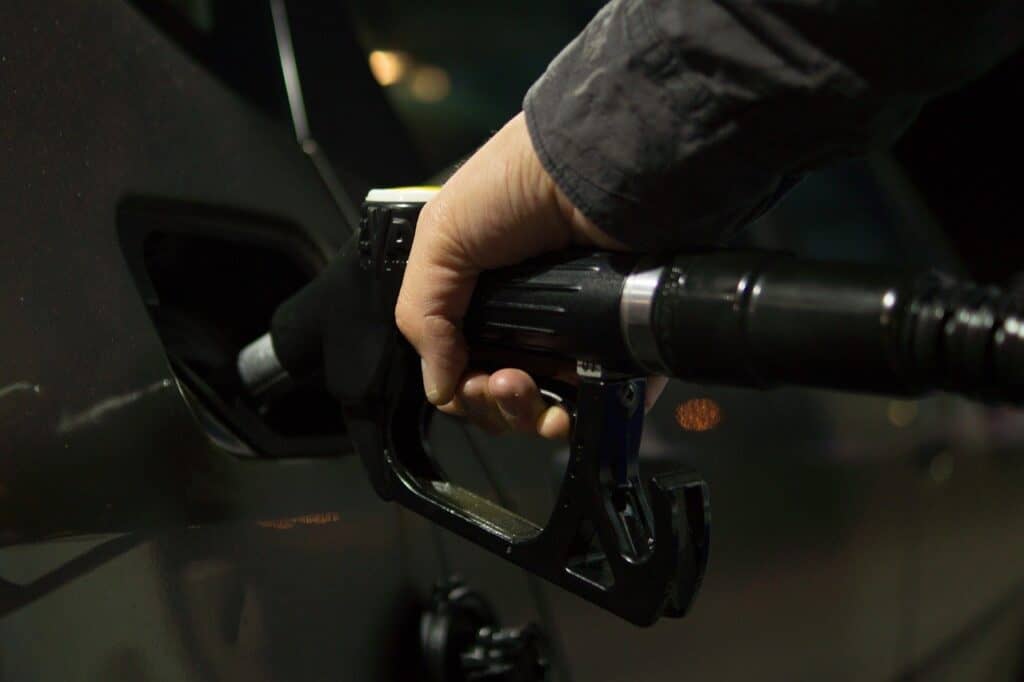Thinking about setting up a nice campfire this year or disposing of some old wood by burning it off but wondering just how hot things can get? It can vary quite a bit, but let’s see how hot wood gets when it burns.
There are many different types of wood and some burn at temperatures as low as 930 degrees Fahrenheit (500 celsius) and others may burn as high as 2000 degrees Fahrenheit (1093 celsius). The temperature can be affected by a variety of things.
In this article, we will talk more about the different things that affect a wood fire temperature, what temperature wood will ignite at, whether or not wood can melt or evaporate, and see what the average temperature of a campfire is. Here’s what you need to know.
Your # 1 priority is keeping your family safe. As a firefighter, I recommend everyone has updated smoke detectors that don’t require battery changes, like these ones from Kidde, a fire extinguisher, like this one from Amerex, and a fire escape ladder if you have bedrooms above the first floor, I recommend this one from Hausse.
Also read: What Is The Temperature Of Fire? How Hot Does it Get?
What Temperature Does Wood Ignite?

Wood undergoes a fairly complex process known as “pyrolysis” when it catches fire. It’s a three-stage process and allows the wood to decompose effectively as it burns.
Firstly, at about 320 degrees Fahrenheit up to about 500 degrees, the wood will start to burn and you can see it change in a way that can’t be reversed (char marks, cracking, shrinking, etc.) and at some point (anywhere above about 390 degrees) the wood will catch fire.
So, wood ignites at temperatures between 390 degrees Fahrenheit and 500 degrees.
The next phase of pyrolysis is hotter and the decomposition becomes more rapid and begins to consume the wood at a decent rate. This takes place between 500 and 800 degrees.
After that, you start to reach temperatures known as “burning furnaces”. All the wood at this stage should completely ignite and the only residue should be a sort of burning coal.
This video illustrates the wood ignition process:
Also read: House Fire Temperature: How Hot Does It Get?
What Temperature Does It Burn At?
The species of the tree has a lot to do with the “wood burning temperature” of the wood that it produces. No surprises, right?
Possibly the lowest temperature burn of any commonly available wood is Victorian Ash which can produce flames of around 592 degrees Fahrenheit.
At the other end of the scale, you have the mighty birch tree which is quite happy to create a full-on inferno and can burn at temperatures of 1,500 degrees or more!
As wood burns, it undergoes several changes.
Firstly, a lot of the water weight begins to disappear as the water boils off – freshly cut wood has around half its weight in water, wood that has been given a season to dry out, on the other hand, has about a fifth of its weight as water content.
Wet wood burns with a lower temperature than dry wood. This is because some of the energy is being used to convert the water to vapor rather than being funneled into the flame.
Note: Water expands 1600 times its volume when it is heated and turns to vapor (steam) and this allows it to absorb a ton of heat. That is one of the reasons that water is so effective at putting out fires.
You should also find that burning wood produces smoke – these are flammable gasses produced by the burning process and they require oxygen to be present in order to sustain themselves.
Then pyrolysis occurs and the majority of the energy in the wood is released in the form of flame and heat.
To better understand the science of the wood combustion process, watch this:
Also read: At What Temperature Does Paper Burn/Ignite? Revealed
What’s the Flashpoint?
This depends entirely on the type of wood you have to burn.
Typical firewood has a flashpoint (that is the lowest possible temperature of combustion) of around 570 degrees Fahrenheit.
However, as we’ve already seen some species of tree produce much lower flashpoints and Birch is going to require much more energy to burn.
Also read: Is Bamboo Flammable? Examined
What’s the Melting Point?
Can wood even melt?
Melting, from a physical perspective, requires a couple of changes in the structure of a substance.
Firstly, the molecules in the solid form of the substance must essentially be broken apart from each other.
Secondly, the molecules must then be able to move freely around each other – creating a current of sorts.
However, while it does this – the chemical properties of the substance are meant to remain the same. So, for example, if you melt gold, you get liquid gold as an end product rather than a new substance.
When it comes to wood, the first problem is that if you try to heat it enough to melt – it’s going to catch fire. When it catches fire, the wood oxidizes that is the individual molecules break down and combine with oxygen in the air to become new compounds.
That means that under normal conditions wood doesn’t melt because it changes its chemical structure, instead.
But could we melt wood if we just made it hot enough and removed all the oxygen, instead?
Sadly, no. All the water from the wood and volatile chemicals that might lurk within would evaporate, thus, they would be the same as when they began.
However, wood is made up of very long fibrous strands that are made out of cellulose they give wood much of its toughness. These fibers can’t break down when heated into smaller fibers that move freely, the best we could do is focus enough heat on them to break down the “carbonyl” bonds inside.
Unfortunately, once again this would change the substance of the wood. We’d no longer have cellulose fibers; we’d have charcoal and the wood wouldn’t have melted.
However, it might be possible to melt wood if we could keep the pressure at standard, and then raise the temperate to 3,500 degrees Fahrenheit (this is the melting point not of wood but the element carbon – the key building block of the wood).
However, we can’t, as yet, do this and thus, for any practical purposes – wood does not have a melting temperature because it just can’t melt.
Also read: How Hot Is Lightning? Hotter Than The Sun?
Can Wood Evaporate?
Evaporation is an extension of melting. It’s a further breakdown of the molecular structure so that all inter-molecular bonds are removed, and the individual molecules can then float free in the air around them.
As you might expect, if it’s impossible to melt wood, it’s impossible for it to evaporate too. There are some unusual substances that undergo a process of sublimation – that is they transform from solid to gas with no liquid phase in between.
Wood is not one of these substances and that means we’d probably need to get it a temperature of 8,720 degrees Fahrenheit, which is the boiling temperature of carbon.
As we can’t even make it get to 3,500 degrees (the melting point) this theoretical experiment is unlikely to be carried out in practice at any point in the near future.
For now at least, wood doesn’t evaporate.
Also read: Is Cottonwood Good Firewood? It Depends…
How Hot Does a Wood Fire Get?
If you want to measure the heat of a wood fire, you need to know the exact makeup of the woods involved the relative amounts of water in the wood, and if there’s anything else in the fire.
This is, quite clearly, a ridiculously complicated calculation and one which wouldn’t be very useful to us even if we could get it right.
So, it’s better to use an average temperature identified in lab settings and then recognize that there can be substantial variations in these numbers when it comes to practical use.
Also read: How Hot Is A Lighter Flame?
Average Campfire Temperature

A campfire will typically burn at around 1,112 degrees Fahrenheit.
The temperature of the campfire will then rise once most of the wood has been converted to charcoal in the burning process. Charcoal burns at a much higher temperature of approximately 2,012 degrees Fahrenheit.
We would note that back in 2016, campfires were believed to have caused over 60,000 fires in the United States that led to the destruction of 4 million acres of land. That’s because it’s quite hard to put out a fire at this temperature.
To do it properly, make sure the wood has burned completely to ash, then smother it in water (until water no longer hisses) and then, just to be safe, dig some dirt or sand over the top of the fire. Finally, touch the surface (very carefully) to make sure it is no longer hot.
Don’t leave a fire burning behind you.
Conclusion
How hot does wood burn? In general terms, wood will burn up to about 2,000 degrees Fahrenheit depending on the type of wood and the way that a fire has been structured. It is possible to get it to burn at even greater temperatures, but it requires a very specific setup.
However, wood may ignite at lower temperatures, particularly, if it has dried out and has very little water content to resist a flame.
Related Articles
Black Smoke: What Does It Mean And What Causes It?

